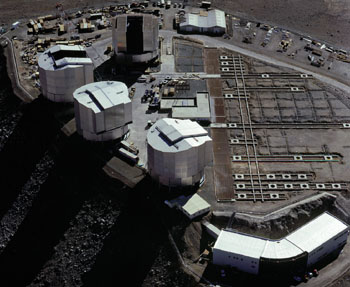Edited by Emma Sanders
Stars seeing stars
Subaru,
a new Japanese telescope,
saw first light in January. It joins the UK infrared telescope,
the Dutch,
UK and Canadian James Clerk Maxwell Telescope and the US Keck Observatory on the 4000 metre Mauna Kea site in Hawaii.
As well as its connotations for the motor industry,
“Subaru” means “to bring together” in Japanese and is also the Japanese word for the Pleiades star cluster.
The 8.3 metre primary mirror is composed of 44 one-ton glass hexagons and its surface is polished to an accuracy of two hundred billionths of a centimetre.
The telescope will be optimized for near-infrared observations,
where it will have a resolution of 0.06 arc-seconds. This is three times as great as the resolution of the Hubble Space Telescope.
Top telescopes

The European Southern Observatory inaugurates its new observatory at Paranal,
Chile,
during the first week of March. Two of the four 8.2 metre telescopes that will make up the Very Large Telescope (VLT) are now complete. The third will follow this autumn.
Construction of the subterranean laboratory,
where light from the telescopes will be analysed,
is well under way. The first interferometric images are expected next year. The VLT will be the world’s most sensitive telescope.
Cluster rides again
The Cluster 2 mission has been given the go-ahead by the European Space Agency review board and is scheduled for launch by two Russian Soyez rockets in mid-2000. The four satellites will,
for the first time,
study the solar wind and the Earth’s magnetosphere in 3-D.
Scientists are particularly interested in the coupling of the Sun and Earth’s magnetic fields. This phenomenon,
called magnetic reconnection,
occurs in large-scale plasmas. Without it,
the Sun and Earth’s magnetic fields would not mix and the stream of electrons and ions in the solar wind would not be channeled into the Earth’s ionosphere.
The process is also important for star formation,
where magnetic pressure would otherwise stop the star from condensing. However,
despite its crucial role,
little is known about magnetic reconnection.
Cluster 2 is almost identical to the original Cluster spacecraft,
which was lost when the first Ariane 5 flight was destroyed in an explosion in June 1996.





